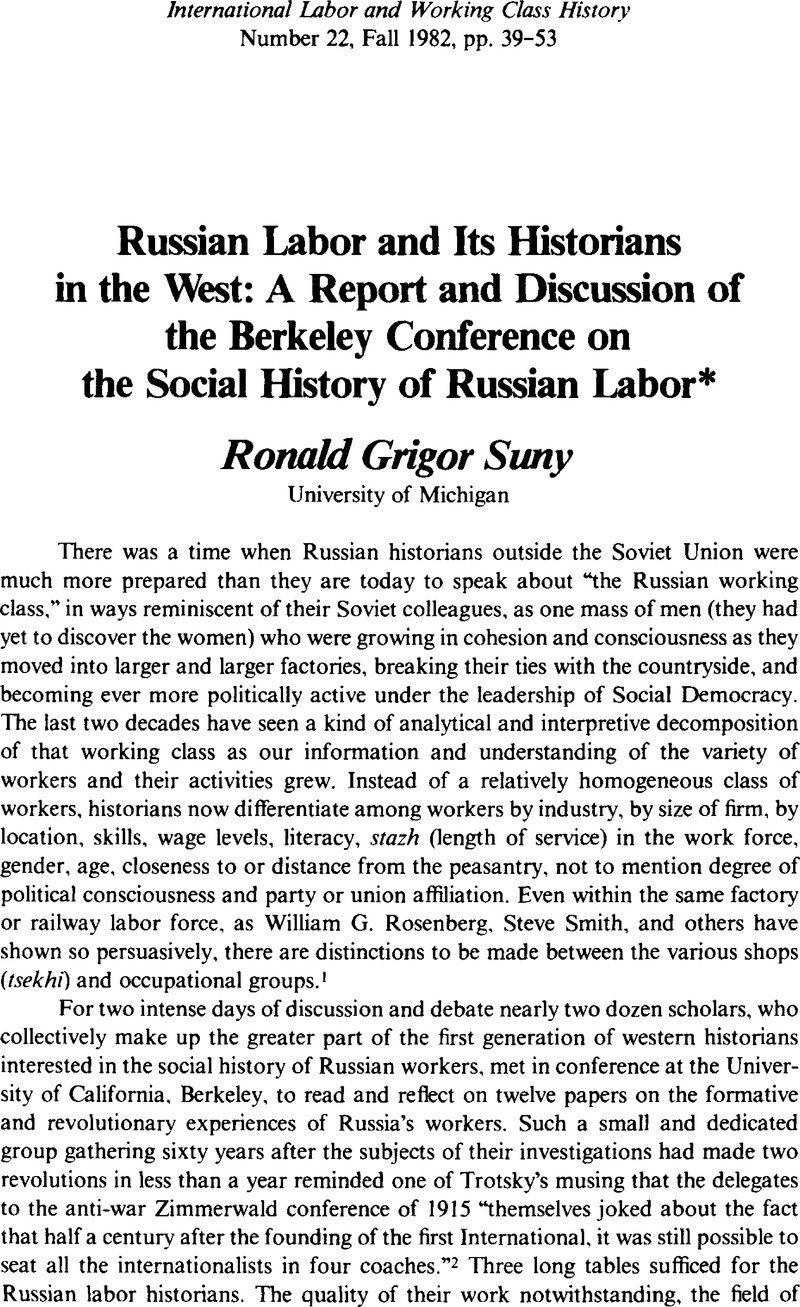Article contents
Russian Labor and Its Historians in the West: A Report and Discussion of the Berkeley Conference on the Social History of Russian Labor*
Published online by Cambridge University Press: 16 December 2008
Abstract

- Type
- Essays
- Information
- Copyright
- Copyright © International Labor and Working-Class History, Inc. 1982
References
NOTES
1. Rosenberg, William G., “Workers and Workers' Control in the Russian Revolution.” History Workshop, 5 (Spring, 1978), 89–97CrossRefGoogle Scholar: Smith, Steve A.. “Craft Consciousness, Class Consciousness: Petrograd 1917.” History Workshop, 11 (Spring, 1981). 33–56.CrossRefGoogle Scholar See also. Bonnell, Victoria E., “Urban Working Class Life in Early Twentieth Century Russia: Some Problems and Patterns.” Russian History, 8, Pt. 3 (1981). 360–378.CrossRefGoogle Scholar
2. Trotsky, Leon. MY Life: An Attempt at Autobiography (New York, 1970), 249.Google Scholar
3. Among the few exceptions to this general neglect of Russian labor's social history were articles by von Laue, Theodore. “Russian Labor Between Field and Factory. 1892–1903.” California Slavic Studies, 3 (1964), 33–65Google Scholar; “Russian Peasants in the Factory” Journal of Economic History, 21 (03 1961), 61–80.Google Scholar
4. Zelnik, Reginald E., Labor and Society in Tsarist Russia: The Factory Workers of St. Petersburg, 1855–1870 (Stanford. 1971)Google Scholar: “Russian Workers and the Revolutionary Movement.” Journal of Social History, 6 (Winter. 1972–1973). 214–236Google Scholar: “Russian Bebels: An Introduction to the Memoirs of Semen Kanatchikov and Matvei Fisher.” Russian Review, 35 (07, 1976), 249–289, and (10, 1976), 417–447.Google ScholarJohnson, Robert Eugene, Peasant and Proletarian: The Working Class of Moscow in the Late Nineteenth Century (New Brunswick, 1979)Google Scholar; Koenker, Diane, Moscow Workers and the 1917 Revolution (Princeton, 1981).Google Scholar
5. See. for example. Brower, Daniel R., “Labor Violence in Russia in the Late Nineteenth Century.” Slavic Review (forthcoming).Google Scholar
6. Without in any way wishing to diminish the considerable contributions to the social history of Russian labor in the work of Robert Johnson, one should note that its strengths stem from its close investigation of the workers' milieu rather than from any discussion of the impact of emerging capitalist relations of production or varying state policies. Johnson prefers a more neutral approach to the context in which workers found themselves and uses a form of the modernization model distinguishing between traditional and industrial society while emphasizing the continuities between them.
7. Bradley, Joseph, “Migration and Mobility in the Urban Labor Force: Moscow. 1880–1900.” 51.Google Scholar
8. Ibid., 48.
9. In the comments on the paper some confusion about the reason for the workers' angry reaction to the opening of the factory windows (it was a hot day in August after all) was cleared up. David Montgomery noted that a high humidity was required in the spinning rooms to keep the thread from breaking. Open windows would lower not only humidity but productivity and therefore wages.
10. On the famous Zuhatov police unions in Russia, see Schneiderman, Jeremiah, Sergei Zuhatov and Revolutionary Marxism: The Struggle for the Working Class in Tsarist Russia (Ithaca. 1976)Google Scholar: Pospielovsky, Dimitry, Russian Police Trade Unionism. Experiment or Provocation. (London, 1971)Google Scholar: Sablinsky, Walter, The Road to Bloody Sunday: Father Gapon and the St. Petersburg Massacre of 190S (Princeton, 1976).Google Scholar
11. For clarifying this point I am grateful to Leopold Haimson and Victoria Bonnell.
12. Surh, Gerald, “Labor Organization in 1905: The Petersburg Pattern,” 14–16.Google Scholar
13. Bonnell, Victoria E., “Social Bases of Labor Activism in St. Petersburg and Moscow Workers' Organizations, 1905–1914.” 30.Google Scholar
14. Ibid., 38–39.
15. If it is true that industrial unionism went against the workers' grain in the peak years of 1905–1906. as Bonnell asserts, it must also be noted that in the dark years of the “reaction” (June 1907–April 1912) most of the craft unions suffered great losses in membership, and the one labor group which held its own and even increased its contingent of organized workers was an industrial union, the metalworkers of Petersburg. Industrial unionism became more important in the prewar years, and many artisanal groups joined the broader organizations. The Petersburg metalworkers, while quite active in 1905 politically, were diverted from forming a union by strikes and protests until the spring of 1906 (Surh, 15). But in the following years that union was marked by an extraordinary staying power and radicalism, in contrast to the craft unions which had been organized earlier in 1905.
16. Smith, S. A., “Spontaneity and Organisation in the Petrograd Labour Movement: February to October 1917.” 30.Google Scholar
- 1
- Cited by




